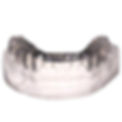Occlusal splints and neuromuscular orthotics: What's the difference?
We are often asked how an occlusal splint differs from a neuromuscular orthotic, which primarily differs in the way it is designed, its form, and its function.
Occlusal splints
Occlusal splints are created by taking impressions of the original bite without taking the muscles into account. In the occlusal splints, the original bite is replicated, so no muscles, joints, or ligaments are treated, and the treatment is focused on protecting the teeth from clenching and grinding forces. By using a flat splint, the original bite is opened a few millimeters, allowing the jaw to be held apart in a new position. The benefits of an occlusal splint are that it protects the teeth from grinding and clenching, and it may ease TMJ symptoms. However, we find that patients still tend to grind using a typical occlusal splint, and although it could help in reducing grinding, occlusal splints are more effective at preventing tooth wear.


neuromuscular orthotic
In contrast, a neuromuscular orthotic starts with the use of a neurotransmitter to determine how the jaw naturally contracts. This natural contraction of the muscles is then used to record the bite in the position of the jaw and where the joints and muscles want to be. As a result, you create a position that matches your natural physiological state rather than where your teeth fit together. The recording is based on what the muscles want to do and this puts the jaw in a position where the muscles feel comfortable, the new orthotic will have anatomy instead of the flat occlusal splint, which also helps in resting the muscles since this creates a position where the muscles, joints and teeth come together and rest.
